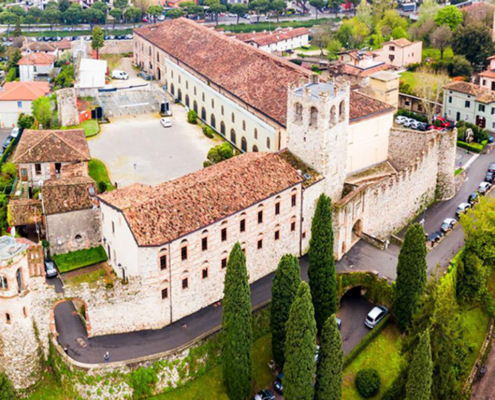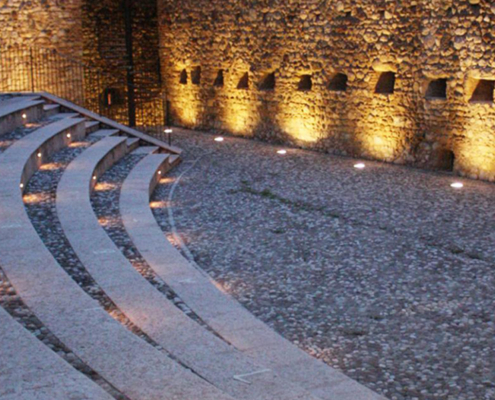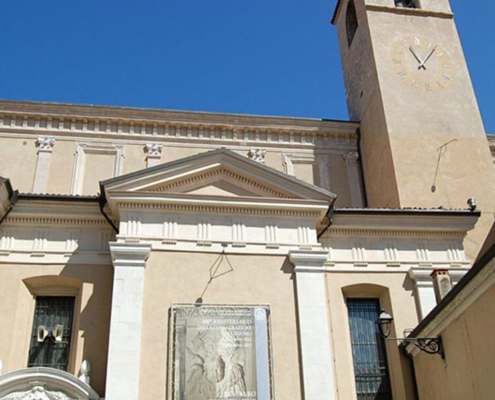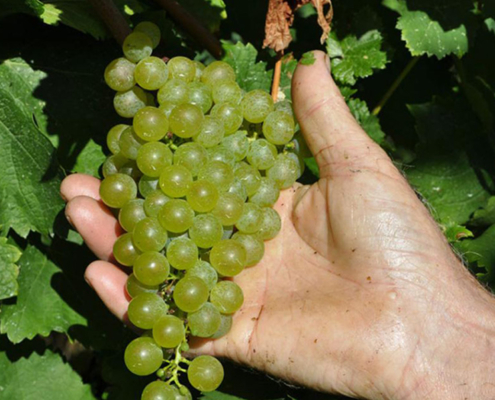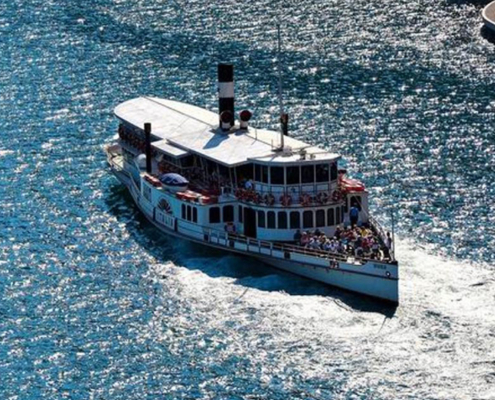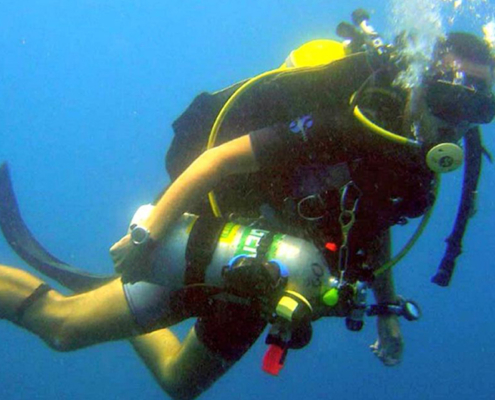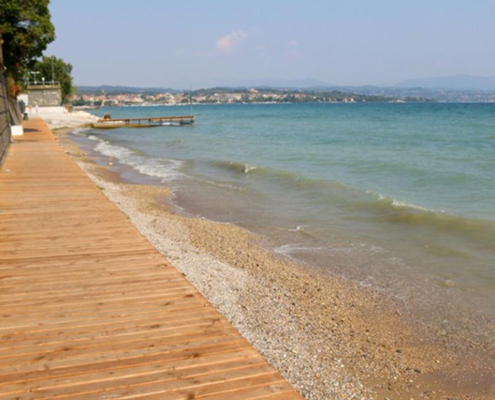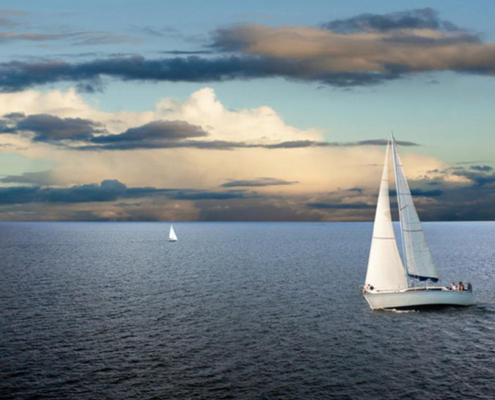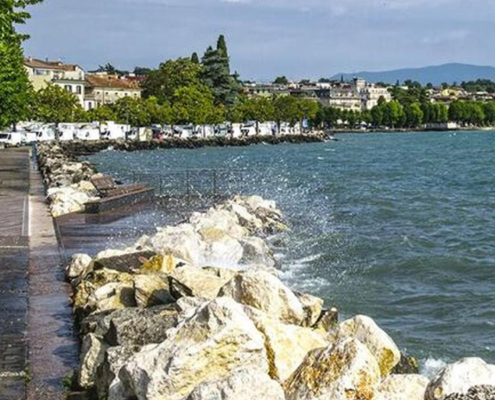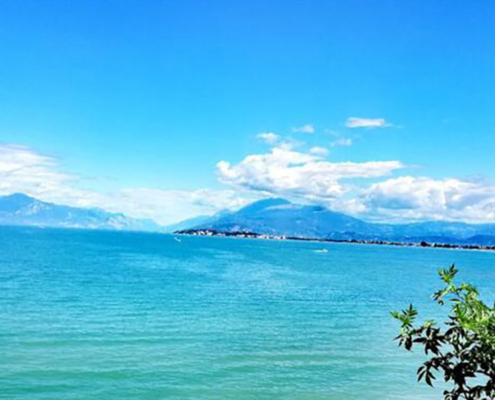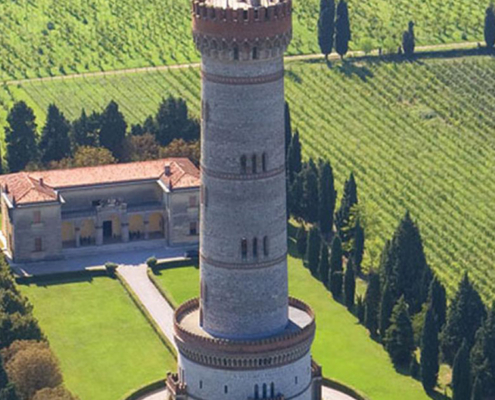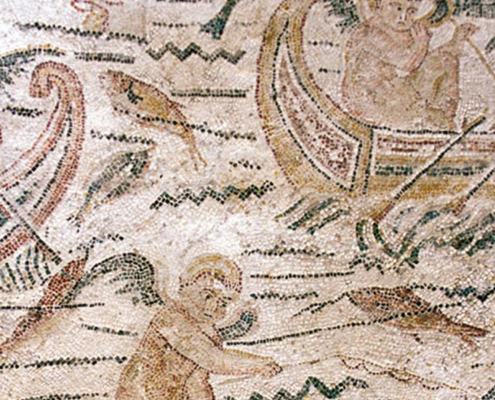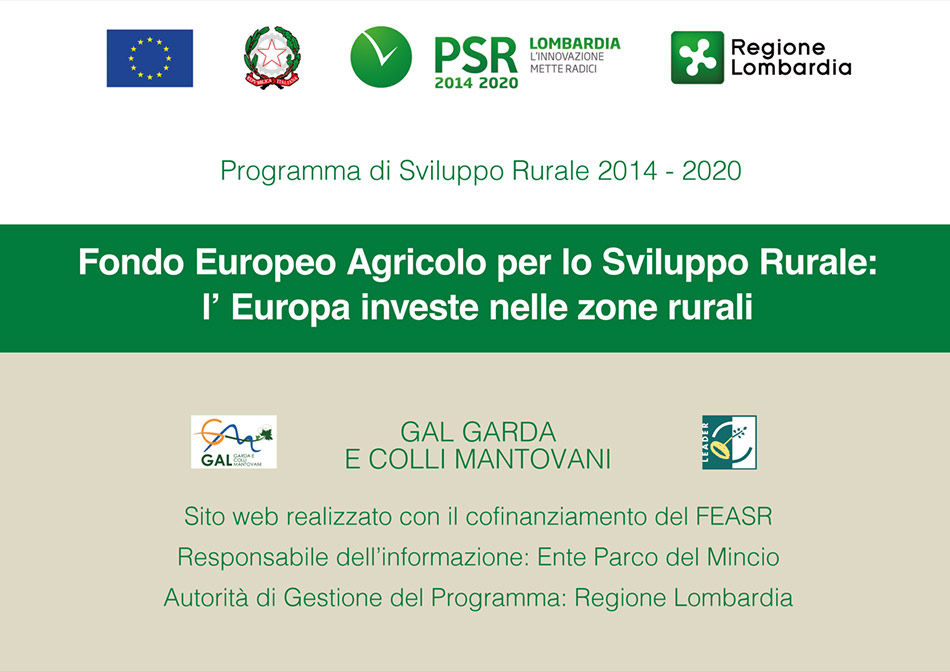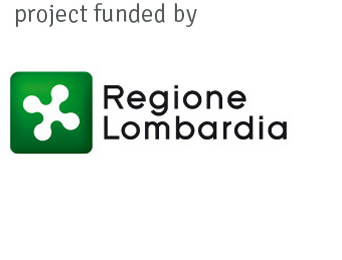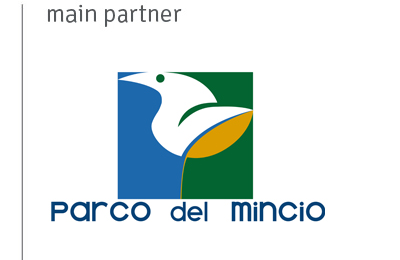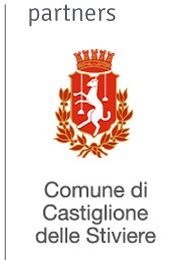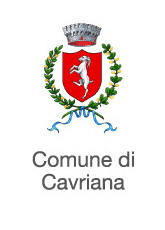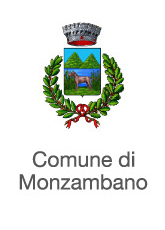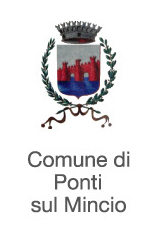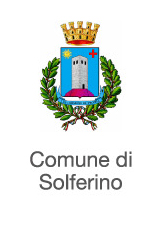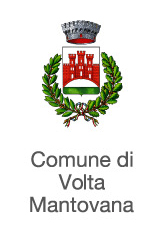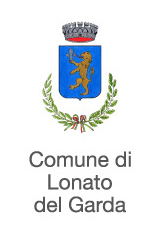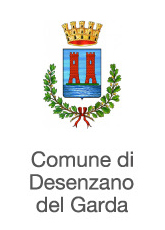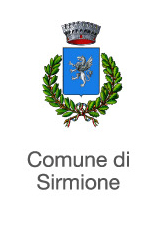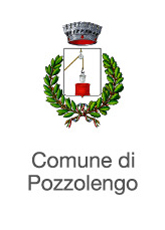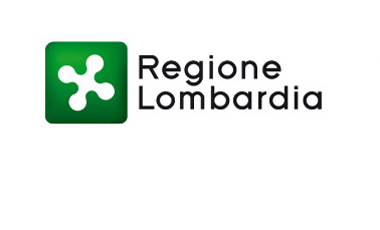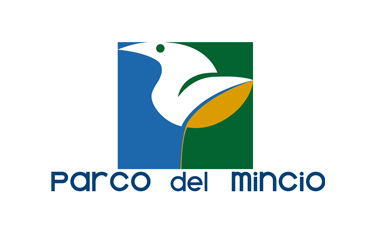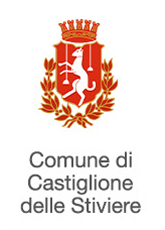Desenzano del Garda
Excavations conducted in 1873 in the Polada area, on the border with Lonato, revealed a Bronze Age pile-dwelling station, from which the name Polada Culture originated. A contemporary settlement discovered in the Lavagnone area has become part of the UNESCO World Heritage Sites.
The remains of the Roman Villa that emerged near Borgo Regio, along the ancient Via Gallica, can be dated between the 2nd and 3rd centuries: in the best preserved parts of the floor, the depictions consist of hunting scenes, scenes of grape harvesting and fruit picking, and finally crosses depicting flowering branches starting from craters. Near Desenzano and the Selva Lugana, Emperor Decius defeated Philip the Arab in 249. In medieval times, Desenzano was subjected to the power of the municipality of Brescia, thanks to the investiture granted by Emperor Henry VI. In 1220 the fiefdom fell under the jurisdiction of the Confalonieri which extended to Rivoltella, San Martino, Solferino, Castiglione and Medole. In 1426 the city became part of the Republic of Venice. During the 15th century, thanks to economic development, the parish church dedicated to Santa Maria Maddalena and the home of the Gialdi family were built, and the Castle was fortified (1480). At the beginning of the 16th century and for a short period of time, Desenzano and Pozzolengo passed to the Duchy of Mantua to return shortly afterwards to the Serenissima on the orders of Louis XII of France. In this period the Academy was founded. During the first decade of the 17th century, further impetus was given to the creation of public works, such as the renovation of the Castle.
The Napoleonic period was also characterized by investments in works such as the new pier and the re-adaptation of the Carmelite Church into a theatre.
Having become part of the Kingdom of Lombardy-Veneto, a dependent state of the Austrian Empire (1814), Desenzano was visited by Emperor Francis I of Austria. Following the events of 1848 and 1849 in which the municipality participated, in 1851 Emperor Franz Joseph visited the town of Desenzano to strengthen trust with the population. During the Battle of Solferino and San Martino in the Second Italian War of Independence, Desenzano became a large hospital for the treatment of the wounded. In 1959, by decree of the President of the Republic, it obtained the title of City.
During the first decade of the 17th century, further impetus was given to the creation of public works, such as the renovation of the Castle.
Good to know
 https://www.territoridipace.it/en/wp-content/uploads/2023/12/oasi-naturale-desenzano.jpg
600
800
martina
https://www.territoridipace.it/en/wp-content/uploads/2023/10/logo_tdp.png
martina2023-12-06 15:56:292024-01-24 10:27:51Natural Monument of San Francesco
https://www.territoridipace.it/en/wp-content/uploads/2023/12/oasi-naturale-desenzano.jpg
600
800
martina
https://www.territoridipace.it/en/wp-content/uploads/2023/10/logo_tdp.png
martina2023-12-06 15:56:292024-01-24 10:27:51Natural Monument of San Francesco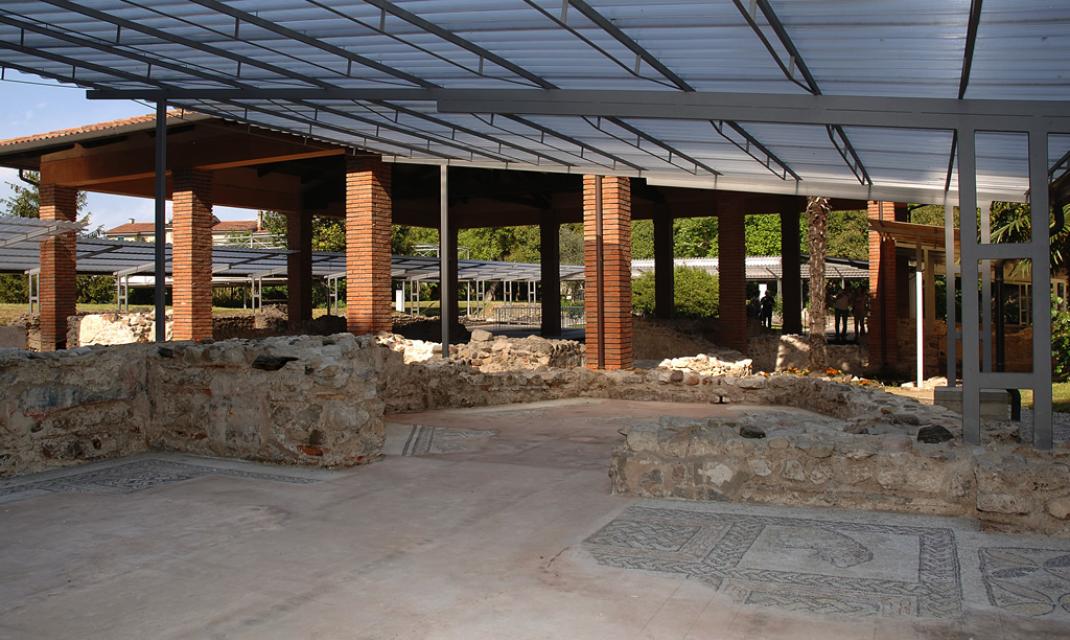 https://www.territoridipace.it/en/wp-content/uploads/2023/11/crop-1-7.jpeg
640
1070
martina
https://www.territoridipace.it/en/wp-content/uploads/2023/10/logo_tdp.png
martina2023-11-23 14:35:362024-01-24 16:29:43Roman villa in Desenzano del Garda
https://www.territoridipace.it/en/wp-content/uploads/2023/11/crop-1-7.jpeg
640
1070
martina
https://www.territoridipace.it/en/wp-content/uploads/2023/10/logo_tdp.png
martina2023-11-23 14:35:362024-01-24 16:29:43Roman villa in Desenzano del Garda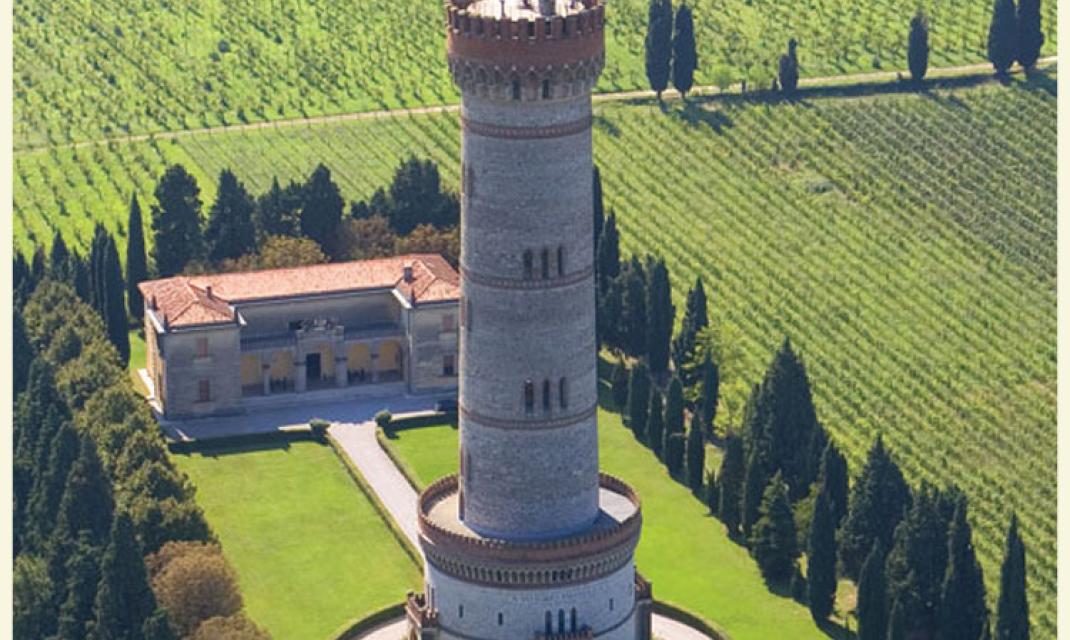 https://www.territoridipace.it/en/wp-content/uploads/2023/11/crop-3-1.jpeg
640
1070
martina
https://www.territoridipace.it/en/wp-content/uploads/2023/10/logo_tdp.png
martina2023-11-23 14:34:022024-01-24 16:30:36Tower of San Martino della Battaglia
https://www.territoridipace.it/en/wp-content/uploads/2023/11/crop-3-1.jpeg
640
1070
martina
https://www.territoridipace.it/en/wp-content/uploads/2023/10/logo_tdp.png
martina2023-11-23 14:34:022024-01-24 16:30:36Tower of San Martino della Battaglia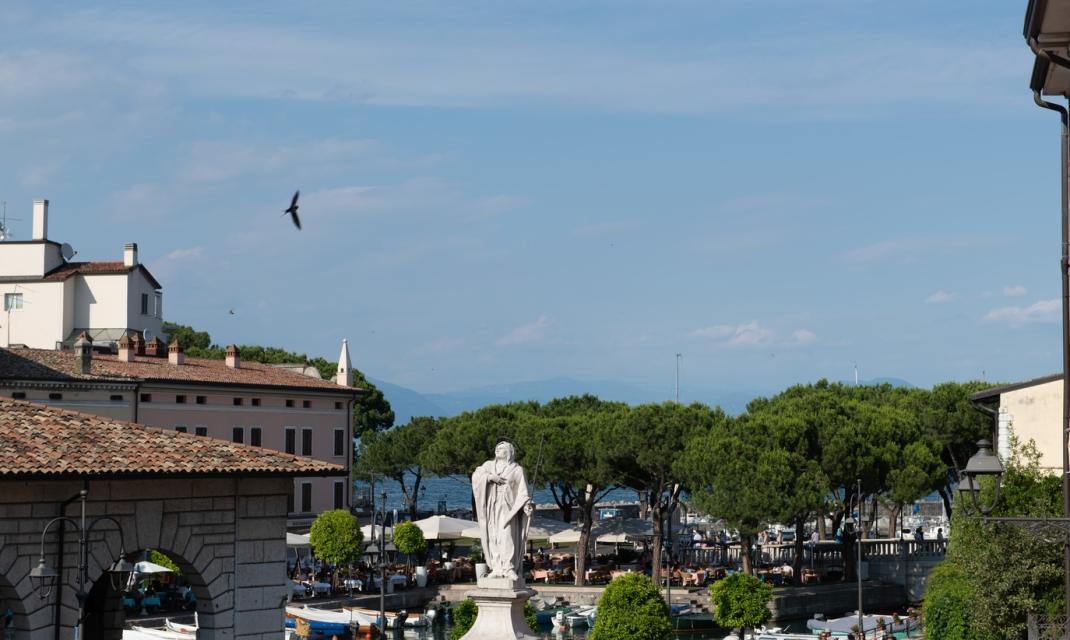 https://www.territoridipace.it/en/wp-content/uploads/2023/11/crop-8.jpeg
640
1070
martina
https://www.territoridipace.it/en/wp-content/uploads/2023/10/logo_tdp.png
martina2023-11-23 14:28:512024-01-24 16:31:18Saint Angela Merici, patron saint of Desenzano del Garda
https://www.territoridipace.it/en/wp-content/uploads/2023/11/crop-8.jpeg
640
1070
martina
https://www.territoridipace.it/en/wp-content/uploads/2023/10/logo_tdp.png
martina2023-11-23 14:28:512024-01-24 16:31:18Saint Angela Merici, patron saint of Desenzano del Garda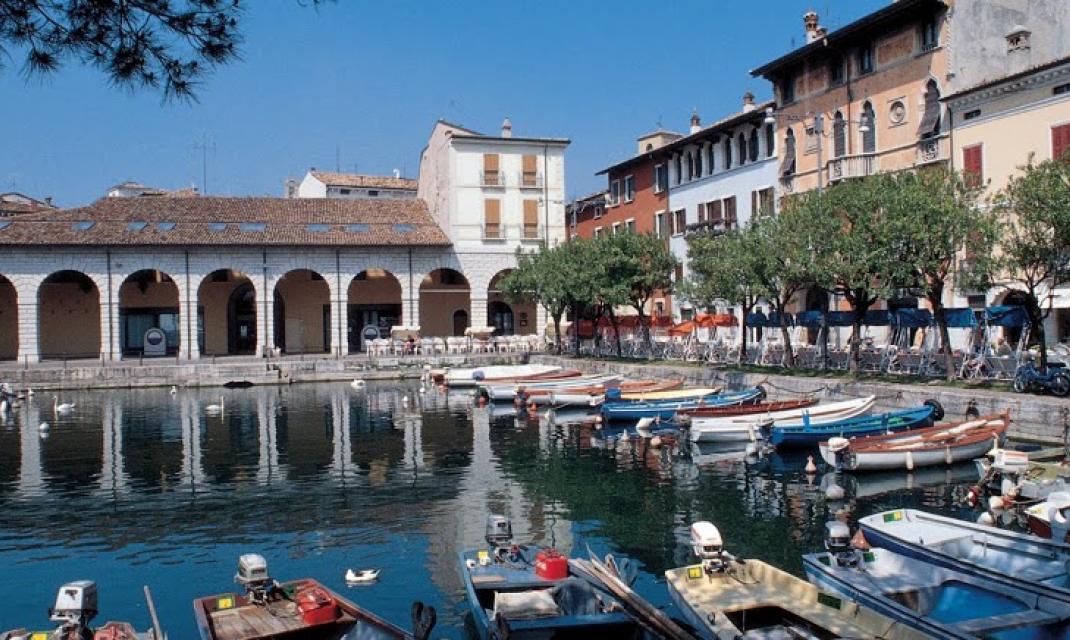 https://www.territoridipace.it/en/wp-content/uploads/2023/11/crop-7.jpeg
640
1070
martina
https://www.territoridipace.it/en/wp-content/uploads/2023/10/logo_tdp.png
martina2023-11-23 14:27:442024-01-24 16:32:03Palazzo Todeschini and the Porto Vecchio
https://www.territoridipace.it/en/wp-content/uploads/2023/11/crop-7.jpeg
640
1070
martina
https://www.territoridipace.it/en/wp-content/uploads/2023/10/logo_tdp.png
martina2023-11-23 14:27:442024-01-24 16:32:03Palazzo Todeschini and the Porto Vecchio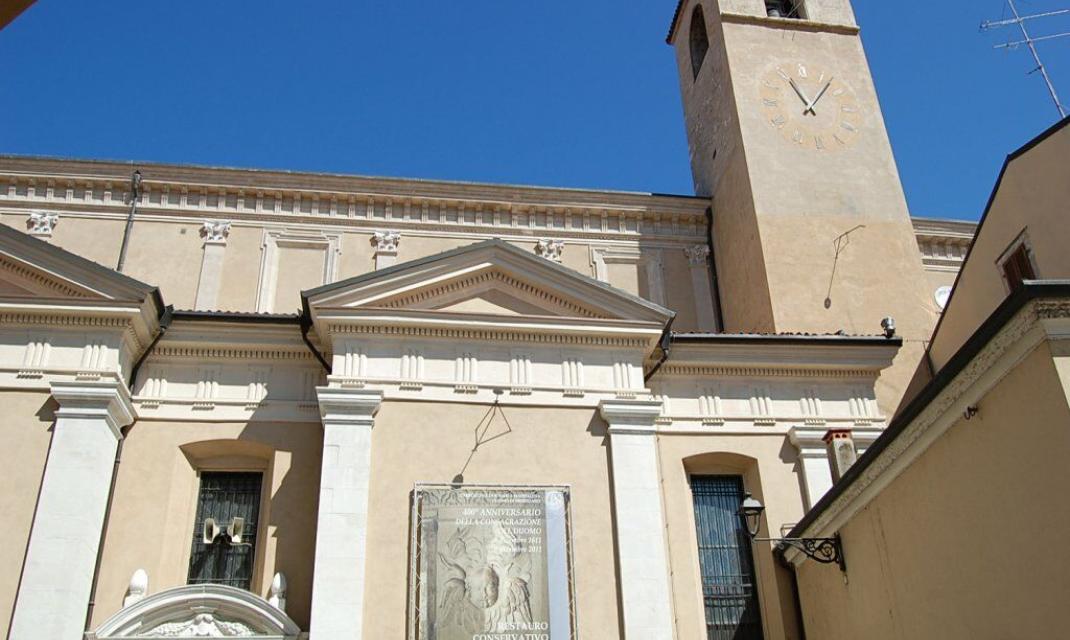 https://www.territoridipace.it/en/wp-content/uploads/2023/11/crop-2-1.jpeg
640
1070
martina
https://www.territoridipace.it/en/wp-content/uploads/2023/10/logo_tdp.png
martina2023-11-23 14:25:192024-01-24 16:32:39The Cathedral of Santa Maria Maddalena
https://www.territoridipace.it/en/wp-content/uploads/2023/11/crop-2-1.jpeg
640
1070
martina
https://www.territoridipace.it/en/wp-content/uploads/2023/10/logo_tdp.png
martina2023-11-23 14:25:192024-01-24 16:32:39The Cathedral of Santa Maria Maddalena 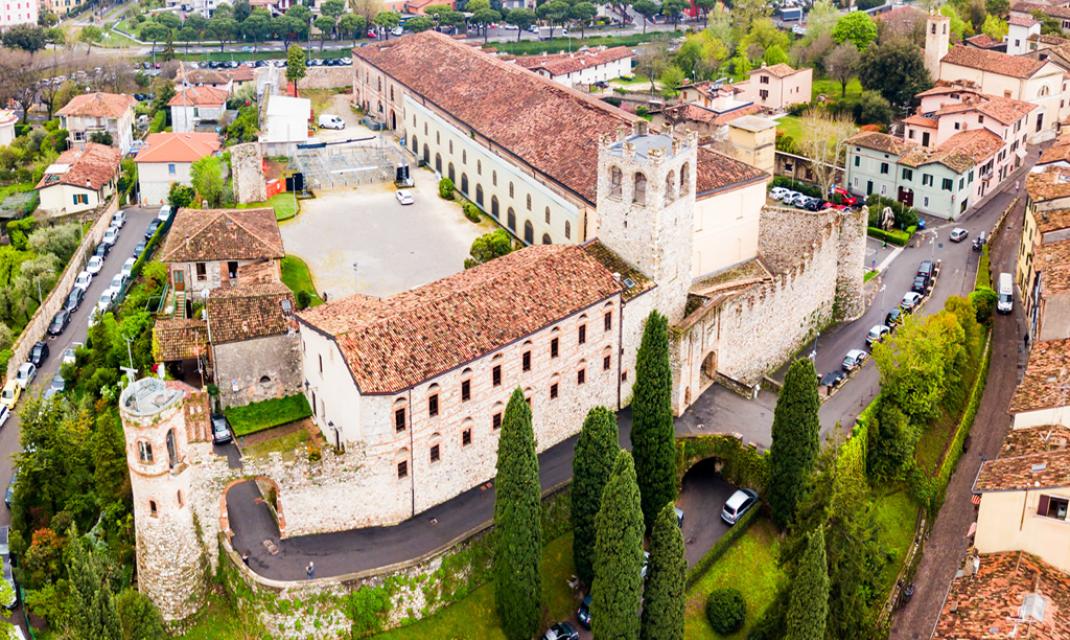 https://www.territoridipace.it/en/wp-content/uploads/2023/11/crop-6.jpeg
640
1070
martina
https://www.territoridipace.it/en/wp-content/uploads/2023/10/logo_tdp.png
martina2023-11-23 14:24:082024-01-24 16:33:26The Castle of Desenzano del Garda
https://www.territoridipace.it/en/wp-content/uploads/2023/11/crop-6.jpeg
640
1070
martina
https://www.territoridipace.it/en/wp-content/uploads/2023/10/logo_tdp.png
martina2023-11-23 14:24:082024-01-24 16:33:26The Castle of Desenzano del Garda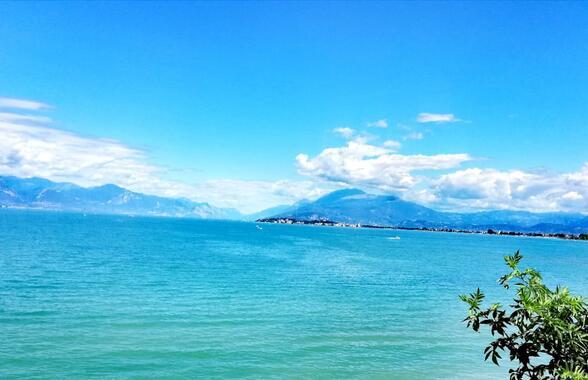 https://www.territoridipace.it/en/wp-content/uploads/2023/11/crop-5.jpeg
380
588
martina
https://www.territoridipace.it/en/wp-content/uploads/2023/10/logo_tdp.png
martina2023-11-23 14:22:502024-01-24 16:34:04Towards Sirmione, along the lake
https://www.territoridipace.it/en/wp-content/uploads/2023/11/crop-5.jpeg
380
588
martina
https://www.territoridipace.it/en/wp-content/uploads/2023/10/logo_tdp.png
martina2023-11-23 14:22:502024-01-24 16:34:04Towards Sirmione, along the lake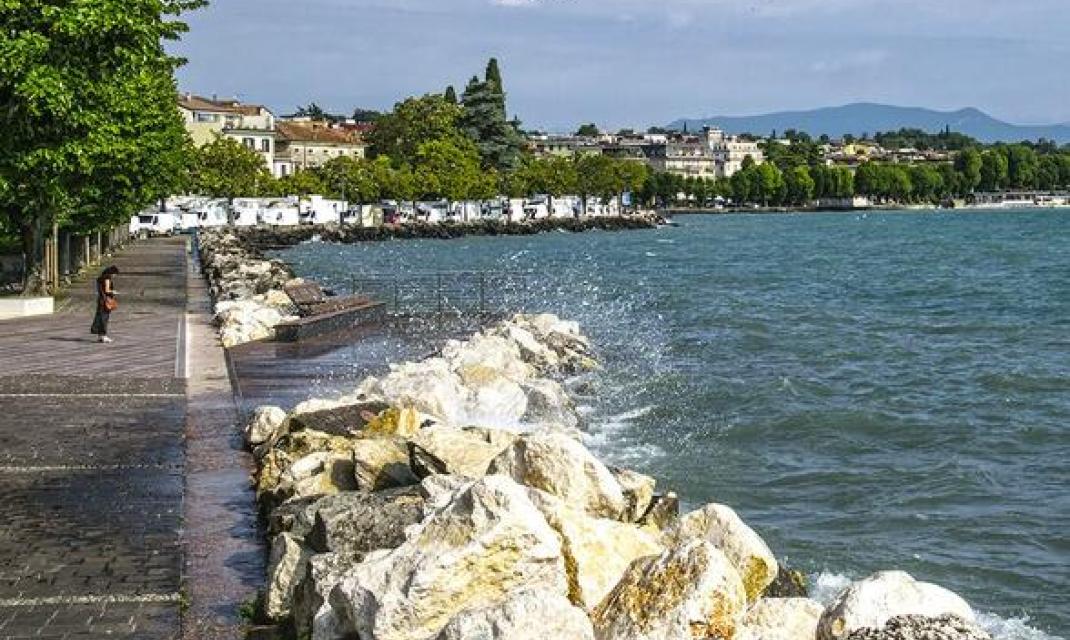 https://www.territoridipace.it/en/wp-content/uploads/2023/11/crop-1-5.jpeg
640
1070
martina
https://www.territoridipace.it/en/wp-content/uploads/2023/10/logo_tdp.png
martina2023-11-23 14:21:062024-01-24 16:34:27Towards the Abbey of Maguzzano
https://www.territoridipace.it/en/wp-content/uploads/2023/11/crop-1-5.jpeg
640
1070
martina
https://www.territoridipace.it/en/wp-content/uploads/2023/10/logo_tdp.png
martina2023-11-23 14:21:062024-01-24 16:34:27Towards the Abbey of Maguzzano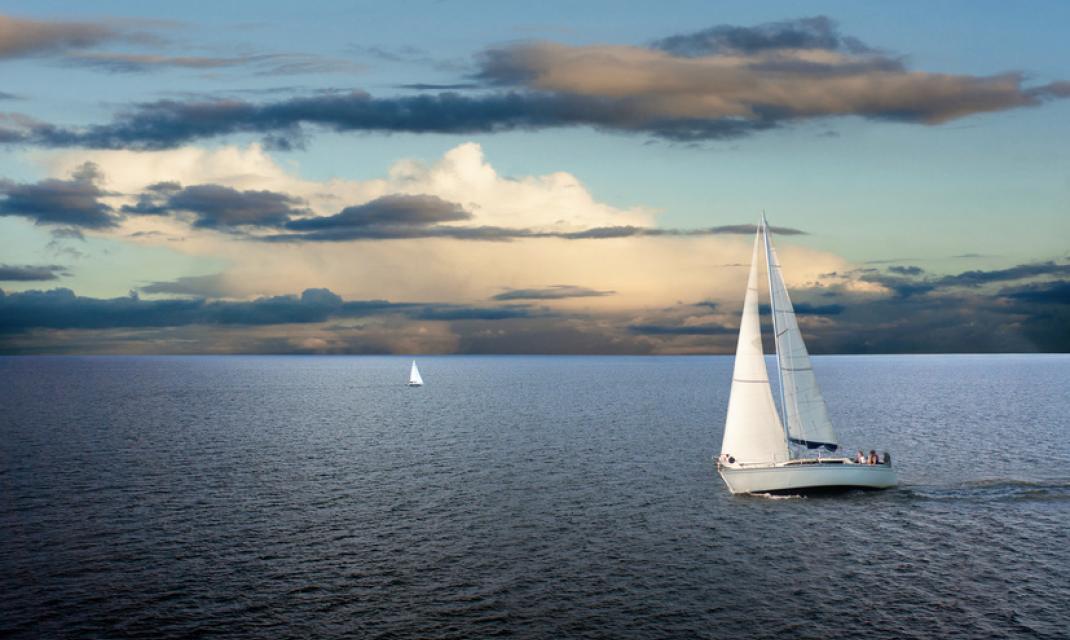 https://www.territoridipace.it/en/wp-content/uploads/2023/11/crop-4.jpeg
640
1070
martina
https://www.territoridipace.it/en/wp-content/uploads/2023/10/logo_tdp.png
martina2023-11-23 14:19:362024-01-24 16:34:46Sailing on the lake
https://www.territoridipace.it/en/wp-content/uploads/2023/11/crop-4.jpeg
640
1070
martina
https://www.territoridipace.it/en/wp-content/uploads/2023/10/logo_tdp.png
martina2023-11-23 14:19:362024-01-24 16:34:46Sailing on the lake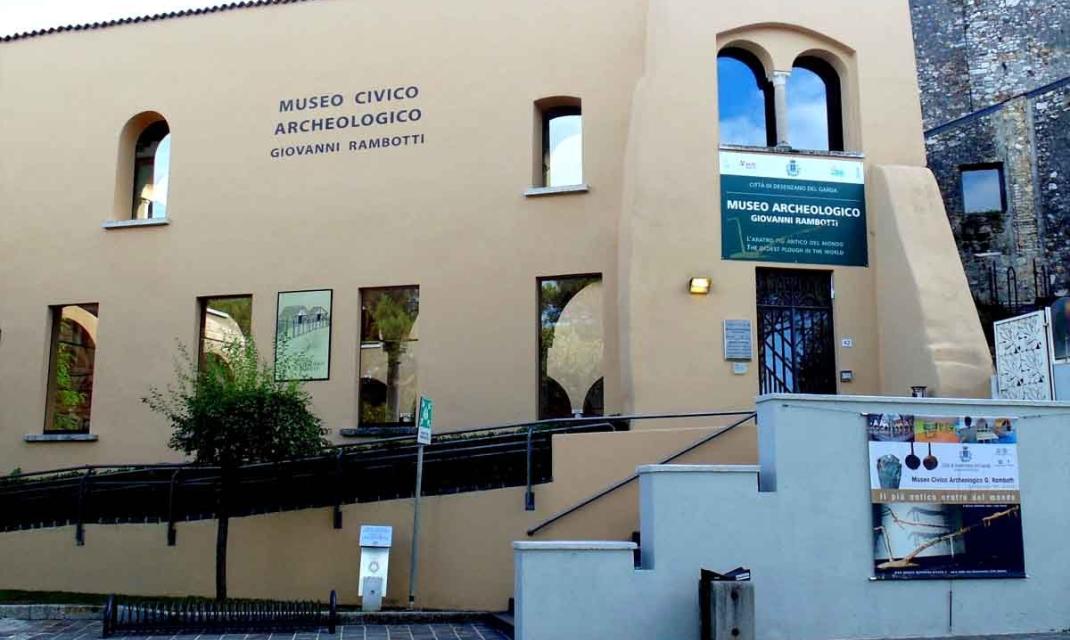 https://www.territoridipace.it/en/wp-content/uploads/2023/11/crop-1-6.jpeg
640
1070
martina
https://www.territoridipace.it/en/wp-content/uploads/2023/10/logo_tdp.png
martina2023-11-23 12:26:352024-01-24 16:35:20“Giovanni Rambotti” Civic Archaeological Museum
https://www.territoridipace.it/en/wp-content/uploads/2023/11/crop-1-6.jpeg
640
1070
martina
https://www.territoridipace.it/en/wp-content/uploads/2023/10/logo_tdp.png
martina2023-11-23 12:26:352024-01-24 16:35:20“Giovanni Rambotti” Civic Archaeological Museum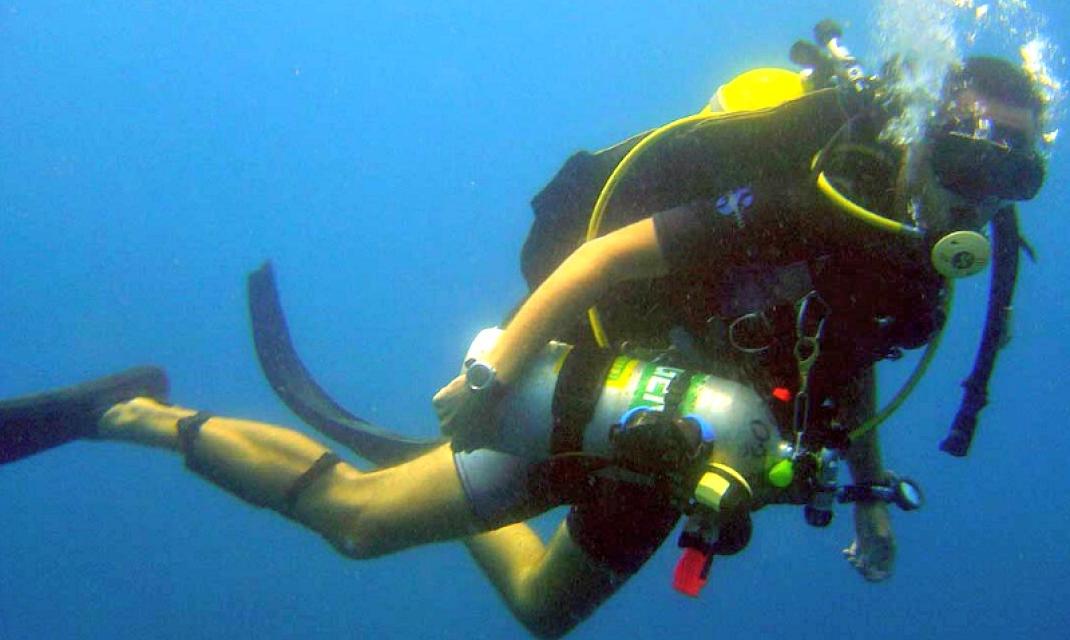 https://www.territoridipace.it/en/wp-content/uploads/2023/11/crop-2.jpeg
640
1070
martina
https://www.territoridipace.it/en/wp-content/uploads/2023/10/logo_tdp.png
martina2023-11-22 17:00:342024-01-24 16:35:50Immersion
https://www.territoridipace.it/en/wp-content/uploads/2023/11/crop-2.jpeg
640
1070
martina
https://www.territoridipace.it/en/wp-content/uploads/2023/10/logo_tdp.png
martina2023-11-22 17:00:342024-01-24 16:35:50Immersion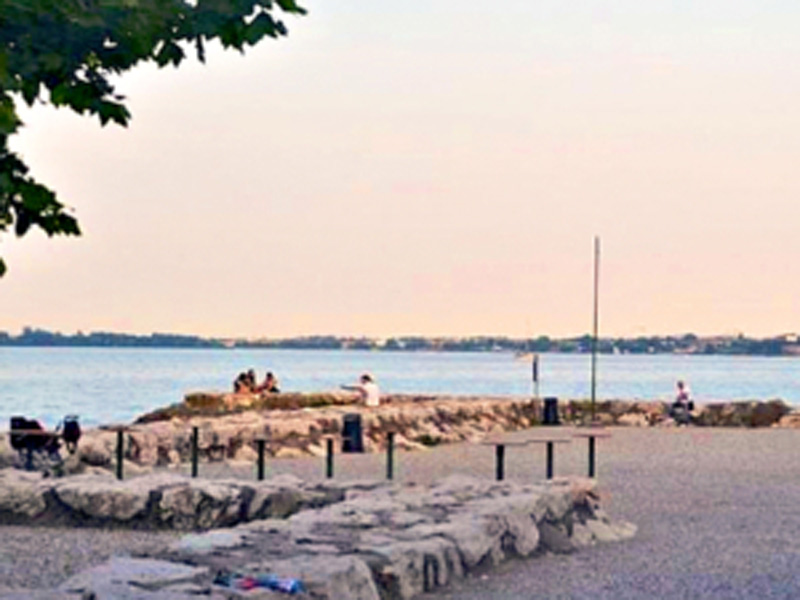 https://www.territoridipace.it/en/wp-content/uploads/2023/11/spiaggia-desenzano.jpg
600
800
martina
https://www.territoridipace.it/en/wp-content/uploads/2023/10/logo_tdp.png
martina2023-11-22 16:55:102024-01-24 16:36:28The beaches in Desenzano
https://www.territoridipace.it/en/wp-content/uploads/2023/11/spiaggia-desenzano.jpg
600
800
martina
https://www.territoridipace.it/en/wp-content/uploads/2023/10/logo_tdp.png
martina2023-11-22 16:55:102024-01-24 16:36:28The beaches in Desenzano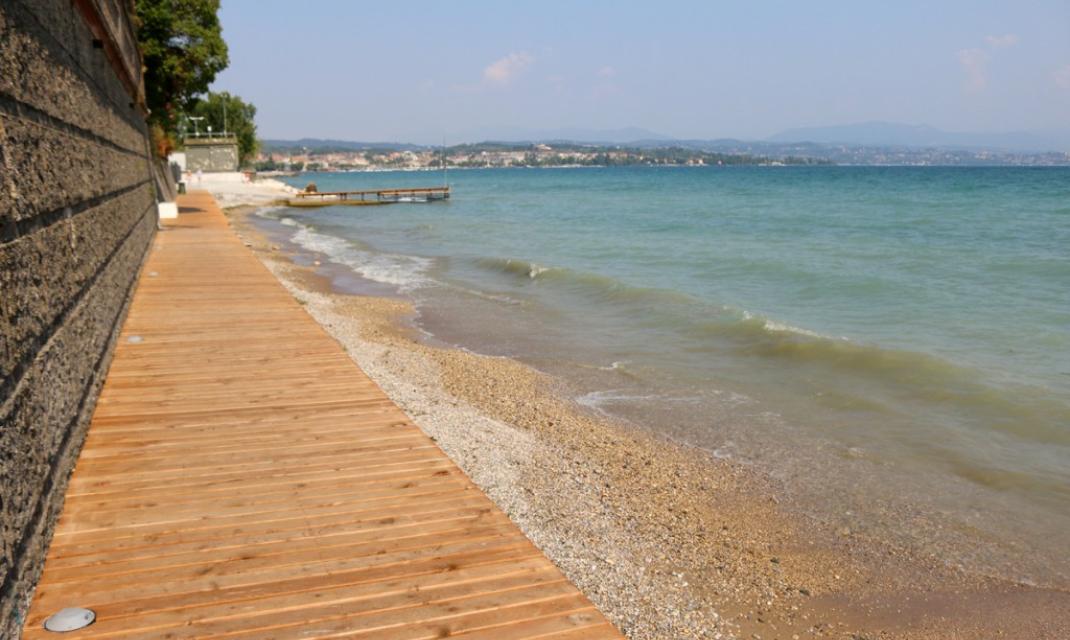 https://www.territoridipace.it/en/wp-content/uploads/2023/11/crop-3.jpeg
640
1070
martina
https://www.territoridipace.it/en/wp-content/uploads/2023/10/logo_tdp.png
martina2023-11-22 16:50:372024-01-24 16:37:23New lakeside walk: from Desenzano to Spiaggia d’Oro
https://www.territoridipace.it/en/wp-content/uploads/2023/11/crop-3.jpeg
640
1070
martina
https://www.territoridipace.it/en/wp-content/uploads/2023/10/logo_tdp.png
martina2023-11-22 16:50:372024-01-24 16:37:23New lakeside walk: from Desenzano to Spiaggia d’Oro https://www.territoridipace.it/en/wp-content/uploads/2023/11/crop-1-4.jpeg
640
1070
martina
https://www.territoridipace.it/en/wp-content/uploads/2023/10/logo_tdp.png
martina2023-11-22 16:45:102024-01-24 16:37:59Golf
https://www.territoridipace.it/en/wp-content/uploads/2023/11/crop-1-4.jpeg
640
1070
martina
https://www.territoridipace.it/en/wp-content/uploads/2023/10/logo_tdp.png
martina2023-11-22 16:45:102024-01-24 16:37:59Golf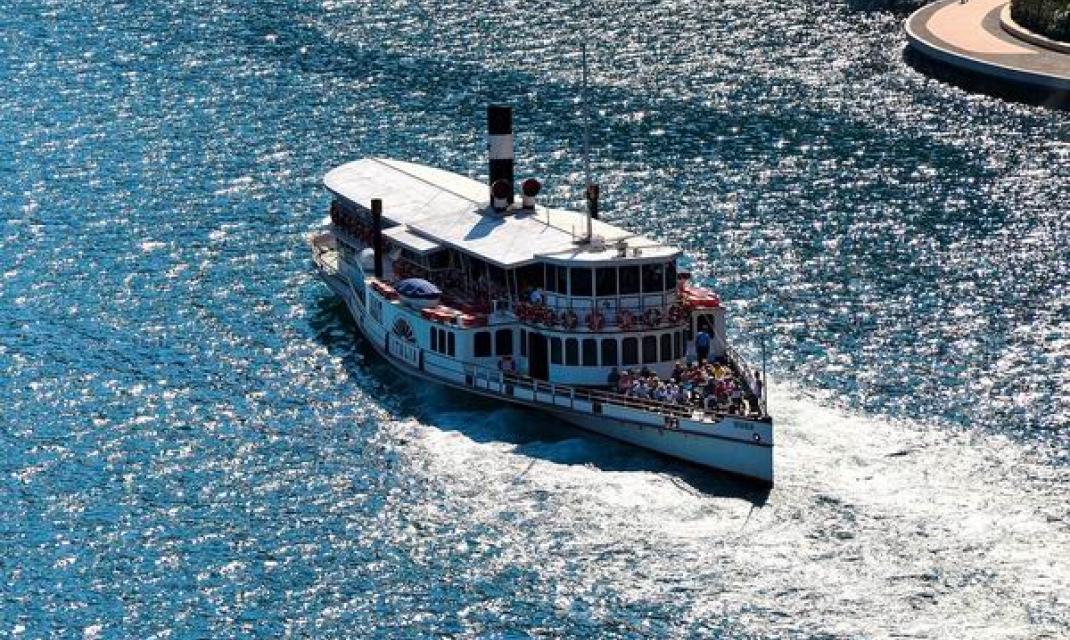 https://www.territoridipace.it/en/wp-content/uploads/2023/11/crop-1-3.jpeg
640
1070
martina
https://www.territoridipace.it/en/wp-content/uploads/2023/10/logo_tdp.png
martina2023-11-22 16:40:162024-01-24 16:38:37Boat trip
https://www.territoridipace.it/en/wp-content/uploads/2023/11/crop-1-3.jpeg
640
1070
martina
https://www.territoridipace.it/en/wp-content/uploads/2023/10/logo_tdp.png
martina2023-11-22 16:40:162024-01-24 16:38:37Boat trip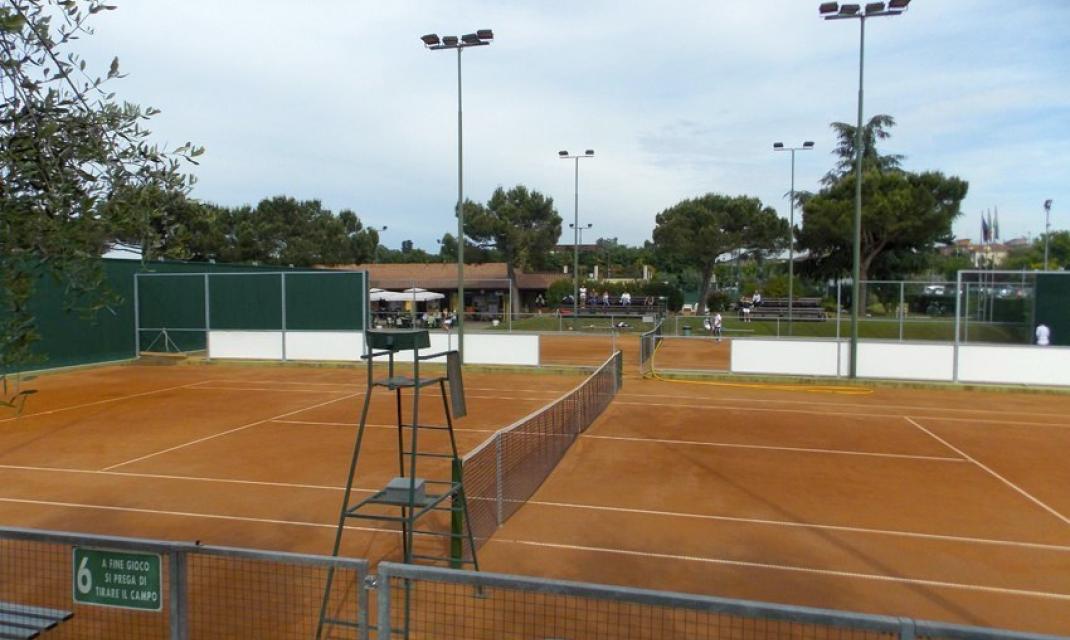 https://www.territoridipace.it/en/wp-content/uploads/2023/11/crop-1-2.jpeg
640
1070
martina
https://www.territoridipace.it/en/wp-content/uploads/2023/10/logo_tdp.png
martina2023-11-22 16:35:182024-01-24 16:39:19“SPIAGGIA D’ORO” Tennis Center
https://www.territoridipace.it/en/wp-content/uploads/2023/11/crop-1-2.jpeg
640
1070
martina
https://www.territoridipace.it/en/wp-content/uploads/2023/10/logo_tdp.png
martina2023-11-22 16:35:182024-01-24 16:39:19“SPIAGGIA D’ORO” Tennis Center https://www.territoridipace.it/en/wp-content/uploads/2023/11/crop.png
640
1070
martina
https://www.territoridipace.it/en/wp-content/uploads/2023/10/logo_tdp.png
martina2023-11-22 16:00:012024-01-24 16:41:52Archery
https://www.territoridipace.it/en/wp-content/uploads/2023/11/crop.png
640
1070
martina
https://www.territoridipace.it/en/wp-content/uploads/2023/10/logo_tdp.png
martina2023-11-22 16:00:012024-01-24 16:41:52Archery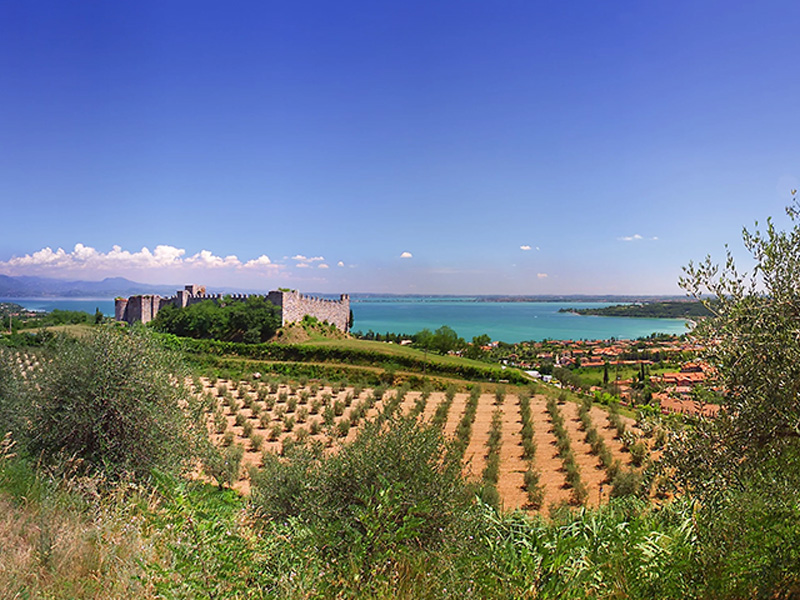 https://www.territoridipace.it/en/wp-content/uploads/2023/12/bike_lonato_padenghe_castello-800x600-1.jpg
600
800
martina
https://www.territoridipace.it/en/wp-content/uploads/2023/10/logo_tdp.png
martina2023-11-06 15:59:012024-01-24 09:40:43Local Park of Supra-municipal Interest (Plis) “Morainic Corridor Park of southern Garda in Brescia”
https://www.territoridipace.it/en/wp-content/uploads/2023/12/bike_lonato_padenghe_castello-800x600-1.jpg
600
800
martina
https://www.territoridipace.it/en/wp-content/uploads/2023/10/logo_tdp.png
martina2023-11-06 15:59:012024-01-24 09:40:43Local Park of Supra-municipal Interest (Plis) “Morainic Corridor Park of southern Garda in Brescia” https://www.territoridipace.it/en/wp-content/uploads/2023/12/oasi-naturale-desenzano.jpg
600
800
martina
https://www.territoridipace.it/en/wp-content/uploads/2023/10/logo_tdp.png
martina2023-12-06 15:56:292024-01-24 10:27:51Natural Monument of San Francesco
https://www.territoridipace.it/en/wp-content/uploads/2023/12/oasi-naturale-desenzano.jpg
600
800
martina
https://www.territoridipace.it/en/wp-content/uploads/2023/10/logo_tdp.png
martina2023-12-06 15:56:292024-01-24 10:27:51Natural Monument of San Francesco https://www.territoridipace.it/en/wp-content/uploads/2023/11/crop-1-7.jpeg
640
1070
martina
https://www.territoridipace.it/en/wp-content/uploads/2023/10/logo_tdp.png
martina2023-11-23 14:35:362024-01-24 16:29:43Roman villa in Desenzano del Garda
https://www.territoridipace.it/en/wp-content/uploads/2023/11/crop-1-7.jpeg
640
1070
martina
https://www.territoridipace.it/en/wp-content/uploads/2023/10/logo_tdp.png
martina2023-11-23 14:35:362024-01-24 16:29:43Roman villa in Desenzano del Garda https://www.territoridipace.it/en/wp-content/uploads/2023/11/crop-3-1.jpeg
640
1070
martina
https://www.territoridipace.it/en/wp-content/uploads/2023/10/logo_tdp.png
martina2023-11-23 14:34:022024-01-24 16:30:36Tower of San Martino della Battaglia
https://www.territoridipace.it/en/wp-content/uploads/2023/11/crop-3-1.jpeg
640
1070
martina
https://www.territoridipace.it/en/wp-content/uploads/2023/10/logo_tdp.png
martina2023-11-23 14:34:022024-01-24 16:30:36Tower of San Martino della Battaglia https://www.territoridipace.it/en/wp-content/uploads/2023/11/crop-8.jpeg
640
1070
martina
https://www.territoridipace.it/en/wp-content/uploads/2023/10/logo_tdp.png
martina2023-11-23 14:28:512024-01-24 16:31:18Saint Angela Merici, patron saint of Desenzano del Garda
https://www.territoridipace.it/en/wp-content/uploads/2023/11/crop-8.jpeg
640
1070
martina
https://www.territoridipace.it/en/wp-content/uploads/2023/10/logo_tdp.png
martina2023-11-23 14:28:512024-01-24 16:31:18Saint Angela Merici, patron saint of Desenzano del Garda https://www.territoridipace.it/en/wp-content/uploads/2023/11/crop-7.jpeg
640
1070
martina
https://www.territoridipace.it/en/wp-content/uploads/2023/10/logo_tdp.png
martina2023-11-23 14:27:442024-01-24 16:32:03Palazzo Todeschini and the Porto Vecchio
https://www.territoridipace.it/en/wp-content/uploads/2023/11/crop-7.jpeg
640
1070
martina
https://www.territoridipace.it/en/wp-content/uploads/2023/10/logo_tdp.png
martina2023-11-23 14:27:442024-01-24 16:32:03Palazzo Todeschini and the Porto Vecchio https://www.territoridipace.it/en/wp-content/uploads/2023/11/crop-2-1.jpeg
640
1070
martina
https://www.territoridipace.it/en/wp-content/uploads/2023/10/logo_tdp.png
martina2023-11-23 14:25:192024-01-24 16:32:39The Cathedral of Santa Maria Maddalena
https://www.territoridipace.it/en/wp-content/uploads/2023/11/crop-2-1.jpeg
640
1070
martina
https://www.territoridipace.it/en/wp-content/uploads/2023/10/logo_tdp.png
martina2023-11-23 14:25:192024-01-24 16:32:39The Cathedral of Santa Maria Maddalena  https://www.territoridipace.it/en/wp-content/uploads/2023/11/crop-6.jpeg
640
1070
martina
https://www.territoridipace.it/en/wp-content/uploads/2023/10/logo_tdp.png
martina2023-11-23 14:24:082024-01-24 16:33:26The Castle of Desenzano del Garda
https://www.territoridipace.it/en/wp-content/uploads/2023/11/crop-6.jpeg
640
1070
martina
https://www.territoridipace.it/en/wp-content/uploads/2023/10/logo_tdp.png
martina2023-11-23 14:24:082024-01-24 16:33:26The Castle of Desenzano del Garda https://www.territoridipace.it/en/wp-content/uploads/2023/11/crop-5.jpeg
380
588
martina
https://www.territoridipace.it/en/wp-content/uploads/2023/10/logo_tdp.png
martina2023-11-23 14:22:502024-01-24 16:34:04Towards Sirmione, along the lake
https://www.territoridipace.it/en/wp-content/uploads/2023/11/crop-5.jpeg
380
588
martina
https://www.territoridipace.it/en/wp-content/uploads/2023/10/logo_tdp.png
martina2023-11-23 14:22:502024-01-24 16:34:04Towards Sirmione, along the lake https://www.territoridipace.it/en/wp-content/uploads/2023/11/crop-1-5.jpeg
640
1070
martina
https://www.territoridipace.it/en/wp-content/uploads/2023/10/logo_tdp.png
martina2023-11-23 14:21:062024-01-24 16:34:27Towards the Abbey of Maguzzano
https://www.territoridipace.it/en/wp-content/uploads/2023/11/crop-1-5.jpeg
640
1070
martina
https://www.territoridipace.it/en/wp-content/uploads/2023/10/logo_tdp.png
martina2023-11-23 14:21:062024-01-24 16:34:27Towards the Abbey of Maguzzano https://www.territoridipace.it/en/wp-content/uploads/2023/11/crop-4.jpeg
640
1070
martina
https://www.territoridipace.it/en/wp-content/uploads/2023/10/logo_tdp.png
martina2023-11-23 14:19:362024-01-24 16:34:46Sailing on the lake
https://www.territoridipace.it/en/wp-content/uploads/2023/11/crop-4.jpeg
640
1070
martina
https://www.territoridipace.it/en/wp-content/uploads/2023/10/logo_tdp.png
martina2023-11-23 14:19:362024-01-24 16:34:46Sailing on the lake https://www.territoridipace.it/en/wp-content/uploads/2023/11/crop-1-6.jpeg
640
1070
martina
https://www.territoridipace.it/en/wp-content/uploads/2023/10/logo_tdp.png
martina2023-11-23 12:26:352024-01-24 16:35:20“Giovanni Rambotti” Civic Archaeological Museum
https://www.territoridipace.it/en/wp-content/uploads/2023/11/crop-1-6.jpeg
640
1070
martina
https://www.territoridipace.it/en/wp-content/uploads/2023/10/logo_tdp.png
martina2023-11-23 12:26:352024-01-24 16:35:20“Giovanni Rambotti” Civic Archaeological Museum https://www.territoridipace.it/en/wp-content/uploads/2023/11/crop-2.jpeg
640
1070
martina
https://www.territoridipace.it/en/wp-content/uploads/2023/10/logo_tdp.png
martina2023-11-22 17:00:342024-01-24 16:35:50Immersion
https://www.territoridipace.it/en/wp-content/uploads/2023/11/crop-2.jpeg
640
1070
martina
https://www.territoridipace.it/en/wp-content/uploads/2023/10/logo_tdp.png
martina2023-11-22 17:00:342024-01-24 16:35:50Immersion https://www.territoridipace.it/en/wp-content/uploads/2023/11/spiaggia-desenzano.jpg
600
800
martina
https://www.territoridipace.it/en/wp-content/uploads/2023/10/logo_tdp.png
martina2023-11-22 16:55:102024-01-24 16:36:28The beaches in Desenzano
https://www.territoridipace.it/en/wp-content/uploads/2023/11/spiaggia-desenzano.jpg
600
800
martina
https://www.territoridipace.it/en/wp-content/uploads/2023/10/logo_tdp.png
martina2023-11-22 16:55:102024-01-24 16:36:28The beaches in Desenzano https://www.territoridipace.it/en/wp-content/uploads/2023/11/crop-3.jpeg
640
1070
martina
https://www.territoridipace.it/en/wp-content/uploads/2023/10/logo_tdp.png
martina2023-11-22 16:50:372024-01-24 16:37:23New lakeside walk: from Desenzano to Spiaggia d’Oro
https://www.territoridipace.it/en/wp-content/uploads/2023/11/crop-3.jpeg
640
1070
martina
https://www.territoridipace.it/en/wp-content/uploads/2023/10/logo_tdp.png
martina2023-11-22 16:50:372024-01-24 16:37:23New lakeside walk: from Desenzano to Spiaggia d’Oro https://www.territoridipace.it/en/wp-content/uploads/2023/11/crop-1-4.jpeg
640
1070
martina
https://www.territoridipace.it/en/wp-content/uploads/2023/10/logo_tdp.png
martina2023-11-22 16:45:102024-01-24 16:37:59Golf
https://www.territoridipace.it/en/wp-content/uploads/2023/11/crop-1-4.jpeg
640
1070
martina
https://www.territoridipace.it/en/wp-content/uploads/2023/10/logo_tdp.png
martina2023-11-22 16:45:102024-01-24 16:37:59Golf https://www.territoridipace.it/en/wp-content/uploads/2023/11/crop-1-3.jpeg
640
1070
martina
https://www.territoridipace.it/en/wp-content/uploads/2023/10/logo_tdp.png
martina2023-11-22 16:40:162024-01-24 16:38:37Boat trip
https://www.territoridipace.it/en/wp-content/uploads/2023/11/crop-1-3.jpeg
640
1070
martina
https://www.territoridipace.it/en/wp-content/uploads/2023/10/logo_tdp.png
martina2023-11-22 16:40:162024-01-24 16:38:37Boat trip https://www.territoridipace.it/en/wp-content/uploads/2023/11/crop-1-2.jpeg
640
1070
martina
https://www.territoridipace.it/en/wp-content/uploads/2023/10/logo_tdp.png
martina2023-11-22 16:35:182024-01-24 16:39:19“SPIAGGIA D’ORO” Tennis Center
https://www.territoridipace.it/en/wp-content/uploads/2023/11/crop-1-2.jpeg
640
1070
martina
https://www.territoridipace.it/en/wp-content/uploads/2023/10/logo_tdp.png
martina2023-11-22 16:35:182024-01-24 16:39:19“SPIAGGIA D’ORO” Tennis Center https://www.territoridipace.it/en/wp-content/uploads/2023/11/crop.png
640
1070
martina
https://www.territoridipace.it/en/wp-content/uploads/2023/10/logo_tdp.png
martina2023-11-22 16:00:012024-01-24 16:41:52Archery
https://www.territoridipace.it/en/wp-content/uploads/2023/11/crop.png
640
1070
martina
https://www.territoridipace.it/en/wp-content/uploads/2023/10/logo_tdp.png
martina2023-11-22 16:00:012024-01-24 16:41:52Archery https://www.territoridipace.it/en/wp-content/uploads/2023/12/bike_lonato_padenghe_castello-800x600-1.jpg
600
800
martina
https://www.territoridipace.it/en/wp-content/uploads/2023/10/logo_tdp.png
martina2023-11-06 15:59:012024-01-24 09:40:43Local Park of Supra-municipal Interest (Plis) “Morainic Corridor Park of southern Garda in Brescia”
https://www.territoridipace.it/en/wp-content/uploads/2023/12/bike_lonato_padenghe_castello-800x600-1.jpg
600
800
martina
https://www.territoridipace.it/en/wp-content/uploads/2023/10/logo_tdp.png
martina2023-11-06 15:59:012024-01-24 09:40:43Local Park of Supra-municipal Interest (Plis) “Morainic Corridor Park of southern Garda in Brescia” https://www.territoridipace.it/en/wp-content/uploads/2023/11/crop-1-7.jpeg
640
1070
martina
https://www.territoridipace.it/en/wp-content/uploads/2023/10/logo_tdp.png
martina2023-11-23 14:35:362024-01-24 16:29:43Roman villa in Desenzano del Garda
https://www.territoridipace.it/en/wp-content/uploads/2023/11/crop-1-7.jpeg
640
1070
martina
https://www.territoridipace.it/en/wp-content/uploads/2023/10/logo_tdp.png
martina2023-11-23 14:35:362024-01-24 16:29:43Roman villa in Desenzano del Garda https://www.territoridipace.it/en/wp-content/uploads/2023/11/crop-3-1.jpeg
640
1070
martina
https://www.territoridipace.it/en/wp-content/uploads/2023/10/logo_tdp.png
martina2023-11-23 14:34:022024-01-24 16:30:36Tower of San Martino della Battaglia
https://www.territoridipace.it/en/wp-content/uploads/2023/11/crop-3-1.jpeg
640
1070
martina
https://www.territoridipace.it/en/wp-content/uploads/2023/10/logo_tdp.png
martina2023-11-23 14:34:022024-01-24 16:30:36Tower of San Martino della Battaglia https://www.territoridipace.it/en/wp-content/uploads/2023/11/crop-7.jpeg
640
1070
martina
https://www.territoridipace.it/en/wp-content/uploads/2023/10/logo_tdp.png
martina2023-11-23 14:27:442024-01-24 16:32:03Palazzo Todeschini and the Porto Vecchio
https://www.territoridipace.it/en/wp-content/uploads/2023/11/crop-7.jpeg
640
1070
martina
https://www.territoridipace.it/en/wp-content/uploads/2023/10/logo_tdp.png
martina2023-11-23 14:27:442024-01-24 16:32:03Palazzo Todeschini and the Porto Vecchio https://www.territoridipace.it/en/wp-content/uploads/2023/11/crop-2-1.jpeg
640
1070
martina
https://www.territoridipace.it/en/wp-content/uploads/2023/10/logo_tdp.png
martina2023-11-23 14:25:192024-01-24 16:32:39The Cathedral of Santa Maria Maddalena
https://www.territoridipace.it/en/wp-content/uploads/2023/11/crop-2-1.jpeg
640
1070
martina
https://www.territoridipace.it/en/wp-content/uploads/2023/10/logo_tdp.png
martina2023-11-23 14:25:192024-01-24 16:32:39The Cathedral of Santa Maria Maddalena  https://www.territoridipace.it/en/wp-content/uploads/2023/11/crop-6.jpeg
640
1070
martina
https://www.territoridipace.it/en/wp-content/uploads/2023/10/logo_tdp.png
martina2023-11-23 14:24:082024-01-24 16:33:26The Castle of Desenzano del Garda
https://www.territoridipace.it/en/wp-content/uploads/2023/11/crop-6.jpeg
640
1070
martina
https://www.territoridipace.it/en/wp-content/uploads/2023/10/logo_tdp.png
martina2023-11-23 14:24:082024-01-24 16:33:26The Castle of Desenzano del Garda https://www.territoridipace.it/en/wp-content/uploads/2023/11/crop-1-7.jpeg
640
1070
martina
https://www.territoridipace.it/en/wp-content/uploads/2023/10/logo_tdp.png
martina2023-11-23 14:35:362024-01-24 16:29:43Roman villa in Desenzano del Garda
https://www.territoridipace.it/en/wp-content/uploads/2023/11/crop-1-7.jpeg
640
1070
martina
https://www.territoridipace.it/en/wp-content/uploads/2023/10/logo_tdp.png
martina2023-11-23 14:35:362024-01-24 16:29:43Roman villa in Desenzano del Garda https://www.territoridipace.it/en/wp-content/uploads/2023/11/crop-3-1.jpeg
640
1070
martina
https://www.territoridipace.it/en/wp-content/uploads/2023/10/logo_tdp.png
martina2023-11-23 14:34:022024-01-24 16:30:36Tower of San Martino della Battaglia
https://www.territoridipace.it/en/wp-content/uploads/2023/11/crop-3-1.jpeg
640
1070
martina
https://www.territoridipace.it/en/wp-content/uploads/2023/10/logo_tdp.png
martina2023-11-23 14:34:022024-01-24 16:30:36Tower of San Martino della Battaglia https://www.territoridipace.it/en/wp-content/uploads/2023/11/crop-7.jpeg
640
1070
martina
https://www.territoridipace.it/en/wp-content/uploads/2023/10/logo_tdp.png
martina2023-11-23 14:27:442024-01-24 16:32:03Palazzo Todeschini and the Porto Vecchio
https://www.territoridipace.it/en/wp-content/uploads/2023/11/crop-7.jpeg
640
1070
martina
https://www.territoridipace.it/en/wp-content/uploads/2023/10/logo_tdp.png
martina2023-11-23 14:27:442024-01-24 16:32:03Palazzo Todeschini and the Porto Vecchio https://www.territoridipace.it/en/wp-content/uploads/2023/11/crop-2-1.jpeg
640
1070
martina
https://www.territoridipace.it/en/wp-content/uploads/2023/10/logo_tdp.png
martina2023-11-23 14:25:192024-01-24 16:32:39The Cathedral of Santa Maria Maddalena
https://www.territoridipace.it/en/wp-content/uploads/2023/11/crop-2-1.jpeg
640
1070
martina
https://www.territoridipace.it/en/wp-content/uploads/2023/10/logo_tdp.png
martina2023-11-23 14:25:192024-01-24 16:32:39The Cathedral of Santa Maria Maddalena 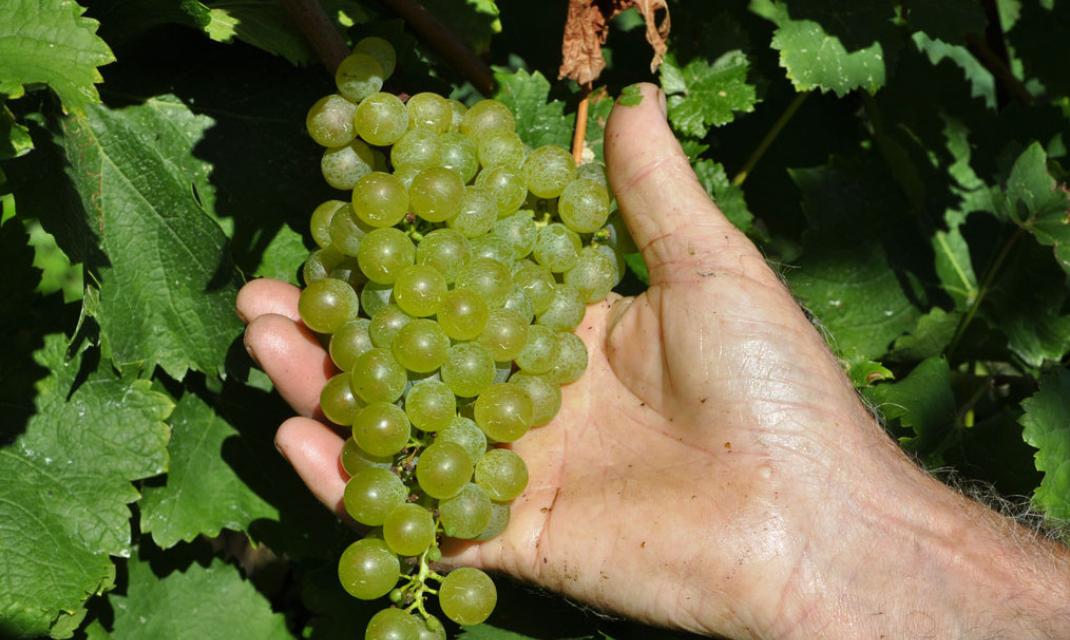 https://www.territoridipace.it/en/wp-content/uploads/2023/11/crop-1.jpeg
640
1070
martina
https://www.territoridipace.it/en/wp-content/uploads/2023/10/logo_tdp.png
martina2023-11-22 16:25:012024-01-24 16:40:56The wines of San Martino della Battaglia Doc
https://www.territoridipace.it/en/wp-content/uploads/2023/11/crop-1.jpeg
640
1070
martina
https://www.territoridipace.it/en/wp-content/uploads/2023/10/logo_tdp.png
martina2023-11-22 16:25:012024-01-24 16:40:56The wines of San Martino della Battaglia Doc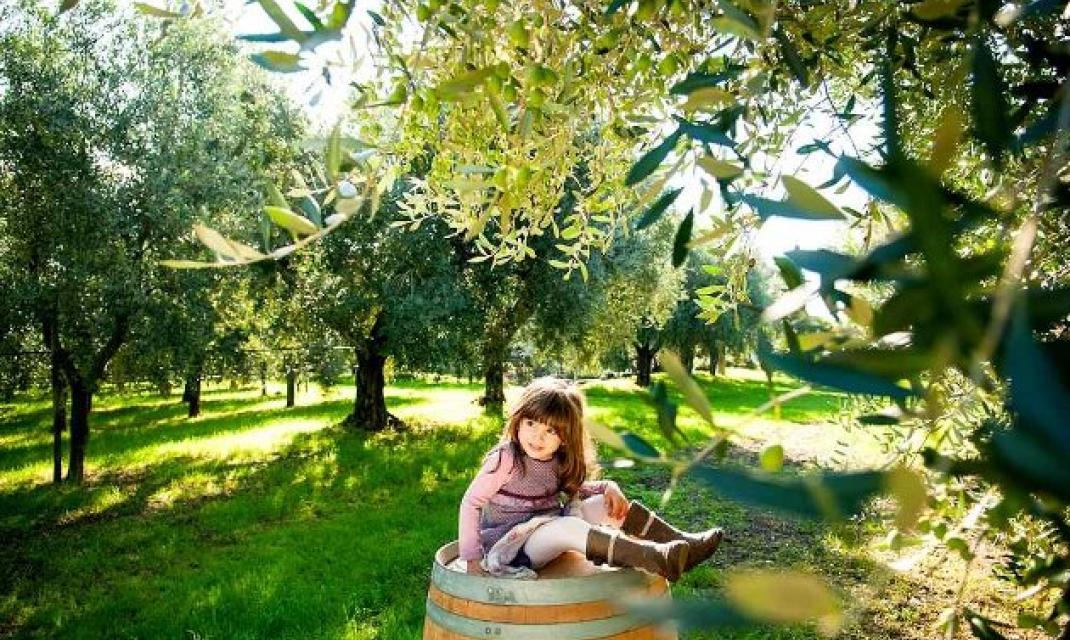 https://www.territoridipace.it/en/wp-content/uploads/2023/11/crop-1-1.jpeg
640
1070
martina
https://www.territoridipace.it/en/wp-content/uploads/2023/10/logo_tdp.png
martina2023-11-22 16:20:122024-01-24 16:41:26Garda Extra Virgin Olive Oil
https://www.territoridipace.it/en/wp-content/uploads/2023/11/crop-1-1.jpeg
640
1070
martina
https://www.territoridipace.it/en/wp-content/uploads/2023/10/logo_tdp.png
martina2023-11-22 16:20:122024-01-24 16:41:26Garda Extra Virgin Olive Oil https://www.territoridipace.it/en/wp-content/uploads/2023/11/crop-1.jpeg
640
1070
martina
https://www.territoridipace.it/en/wp-content/uploads/2023/10/logo_tdp.png
martina2023-11-22 16:25:012024-01-24 16:40:56The wines of San Martino della Battaglia Doc
https://www.territoridipace.it/en/wp-content/uploads/2023/11/crop-1.jpeg
640
1070
martina
https://www.territoridipace.it/en/wp-content/uploads/2023/10/logo_tdp.png
martina2023-11-22 16:25:012024-01-24 16:40:56The wines of San Martino della Battaglia Doc https://www.territoridipace.it/en/wp-content/uploads/2023/11/crop-8.jpeg
640
1070
martina
https://www.territoridipace.it/en/wp-content/uploads/2023/10/logo_tdp.png
martina2023-11-23 14:28:512024-01-24 16:31:18Saint Angela Merici, patron saint of Desenzano del Garda
https://www.territoridipace.it/en/wp-content/uploads/2023/11/crop-8.jpeg
640
1070
martina
https://www.territoridipace.it/en/wp-content/uploads/2023/10/logo_tdp.png
martina2023-11-23 14:28:512024-01-24 16:31:18Saint Angela Merici, patron saint of Desenzano del Garda https://www.territoridipace.it/en/wp-content/uploads/2023/11/crop-5.jpeg
380
588
martina
https://www.territoridipace.it/en/wp-content/uploads/2023/10/logo_tdp.png
martina2023-11-23 14:22:502024-01-24 16:34:04Towards Sirmione, along the lake
https://www.territoridipace.it/en/wp-content/uploads/2023/11/crop-5.jpeg
380
588
martina
https://www.territoridipace.it/en/wp-content/uploads/2023/10/logo_tdp.png
martina2023-11-23 14:22:502024-01-24 16:34:04Towards Sirmione, along the lake https://www.territoridipace.it/en/wp-content/uploads/2023/11/crop-4.jpeg
640
1070
martina
https://www.territoridipace.it/en/wp-content/uploads/2023/10/logo_tdp.png
martina2023-11-23 14:19:362024-01-24 16:34:46Sailing on the lake
https://www.territoridipace.it/en/wp-content/uploads/2023/11/crop-4.jpeg
640
1070
martina
https://www.territoridipace.it/en/wp-content/uploads/2023/10/logo_tdp.png
martina2023-11-23 14:19:362024-01-24 16:34:46Sailing on the lake https://www.territoridipace.it/en/wp-content/uploads/2023/11/crop-1-6.jpeg
640
1070
martina
https://www.territoridipace.it/en/wp-content/uploads/2023/10/logo_tdp.png
martina2023-11-23 12:26:352024-01-24 16:35:20“Giovanni Rambotti” Civic Archaeological Museum
https://www.territoridipace.it/en/wp-content/uploads/2023/11/crop-1-6.jpeg
640
1070
martina
https://www.territoridipace.it/en/wp-content/uploads/2023/10/logo_tdp.png
martina2023-11-23 12:26:352024-01-24 16:35:20“Giovanni Rambotti” Civic Archaeological Museum https://www.territoridipace.it/en/wp-content/uploads/2023/11/crop-2.jpeg
640
1070
martina
https://www.territoridipace.it/en/wp-content/uploads/2023/10/logo_tdp.png
martina2023-11-22 17:00:342024-01-24 16:35:50Immersion
https://www.territoridipace.it/en/wp-content/uploads/2023/11/crop-2.jpeg
640
1070
martina
https://www.territoridipace.it/en/wp-content/uploads/2023/10/logo_tdp.png
martina2023-11-22 17:00:342024-01-24 16:35:50Immersion https://www.territoridipace.it/en/wp-content/uploads/2023/11/spiaggia-desenzano.jpg
600
800
martina
https://www.territoridipace.it/en/wp-content/uploads/2023/10/logo_tdp.png
martina2023-11-22 16:55:102024-01-24 16:36:28The beaches in Desenzano
https://www.territoridipace.it/en/wp-content/uploads/2023/11/spiaggia-desenzano.jpg
600
800
martina
https://www.territoridipace.it/en/wp-content/uploads/2023/10/logo_tdp.png
martina2023-11-22 16:55:102024-01-24 16:36:28The beaches in Desenzano https://www.territoridipace.it/en/wp-content/uploads/2023/11/crop-3.jpeg
640
1070
martina
https://www.territoridipace.it/en/wp-content/uploads/2023/10/logo_tdp.png
martina2023-11-22 16:50:372024-01-24 16:37:23New lakeside walk: from Desenzano to Spiaggia d’Oro
https://www.territoridipace.it/en/wp-content/uploads/2023/11/crop-3.jpeg
640
1070
martina
https://www.territoridipace.it/en/wp-content/uploads/2023/10/logo_tdp.png
martina2023-11-22 16:50:372024-01-24 16:37:23New lakeside walk: from Desenzano to Spiaggia d’Oro https://www.territoridipace.it/en/wp-content/uploads/2023/11/crop-1-4.jpeg
640
1070
martina
https://www.territoridipace.it/en/wp-content/uploads/2023/10/logo_tdp.png
martina2023-11-22 16:45:102024-01-24 16:37:59Golf
https://www.territoridipace.it/en/wp-content/uploads/2023/11/crop-1-4.jpeg
640
1070
martina
https://www.territoridipace.it/en/wp-content/uploads/2023/10/logo_tdp.png
martina2023-11-22 16:45:102024-01-24 16:37:59Golf https://www.territoridipace.it/en/wp-content/uploads/2023/11/crop-1-3.jpeg
640
1070
martina
https://www.territoridipace.it/en/wp-content/uploads/2023/10/logo_tdp.png
martina2023-11-22 16:40:162024-01-24 16:38:37Boat trip
https://www.territoridipace.it/en/wp-content/uploads/2023/11/crop-1-3.jpeg
640
1070
martina
https://www.territoridipace.it/en/wp-content/uploads/2023/10/logo_tdp.png
martina2023-11-22 16:40:162024-01-24 16:38:37Boat trip https://www.territoridipace.it/en/wp-content/uploads/2023/11/crop-1-2.jpeg
640
1070
martina
https://www.territoridipace.it/en/wp-content/uploads/2023/10/logo_tdp.png
martina2023-11-22 16:35:182024-01-24 16:39:19“SPIAGGIA D’ORO” Tennis Center
https://www.territoridipace.it/en/wp-content/uploads/2023/11/crop-1-2.jpeg
640
1070
martina
https://www.territoridipace.it/en/wp-content/uploads/2023/10/logo_tdp.png
martina2023-11-22 16:35:182024-01-24 16:39:19“SPIAGGIA D’ORO” Tennis Center https://www.territoridipace.it/en/wp-content/uploads/2023/11/crop.png
640
1070
martina
https://www.territoridipace.it/en/wp-content/uploads/2023/10/logo_tdp.png
martina2023-11-22 16:00:012024-01-24 16:41:52Archery
https://www.territoridipace.it/en/wp-content/uploads/2023/11/crop.png
640
1070
martina
https://www.territoridipace.it/en/wp-content/uploads/2023/10/logo_tdp.png
martina2023-11-22 16:00:012024-01-24 16:41:52Archery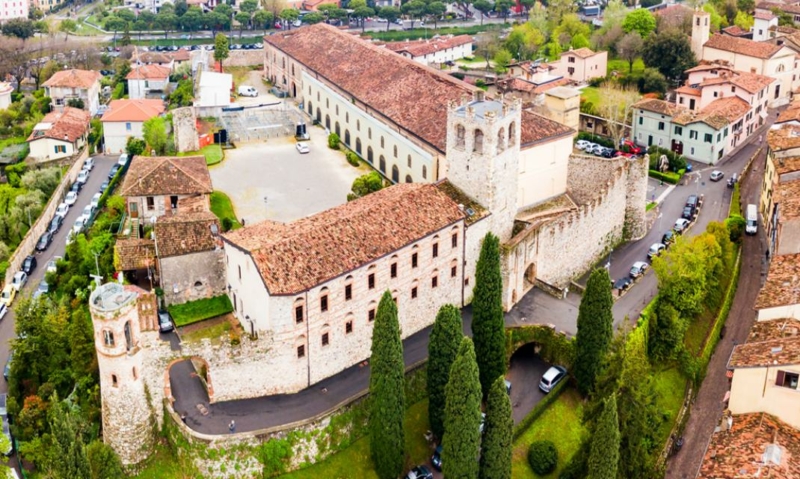 https://www.territoridipace.it/en/wp-content/uploads/2023/11/crop-10-e1700758332574.jpeg
479
800
admin
https://www.territoridipace.it/en/wp-content/uploads/2023/10/logo_tdp.png
admin2023-11-08 15:53:192024-03-07 15:30:01Desenzano
https://www.territoridipace.it/en/wp-content/uploads/2023/11/crop-10-e1700758332574.jpeg
479
800
admin
https://www.territoridipace.it/en/wp-content/uploads/2023/10/logo_tdp.png
admin2023-11-08 15:53:192024-03-07 15:30:01Desenzano https://www.territoridipace.it/en/wp-content/uploads/2023/11/crop-8.jpeg
640
1070
martina
https://www.territoridipace.it/en/wp-content/uploads/2023/10/logo_tdp.png
martina2023-11-23 14:28:512024-01-24 16:31:18Saint Angela Merici, patron saint of Desenzano del Garda
https://www.territoridipace.it/en/wp-content/uploads/2023/11/crop-8.jpeg
640
1070
martina
https://www.territoridipace.it/en/wp-content/uploads/2023/10/logo_tdp.png
martina2023-11-23 14:28:512024-01-24 16:31:18Saint Angela Merici, patron saint of Desenzano del Garda https://www.territoridipace.it/en/wp-content/uploads/2023/11/crop-5.jpeg
380
588
martina
https://www.territoridipace.it/en/wp-content/uploads/2023/10/logo_tdp.png
martina2023-11-23 14:22:502024-01-24 16:34:04Towards Sirmione, along the lake
https://www.territoridipace.it/en/wp-content/uploads/2023/11/crop-5.jpeg
380
588
martina
https://www.territoridipace.it/en/wp-content/uploads/2023/10/logo_tdp.png
martina2023-11-23 14:22:502024-01-24 16:34:04Towards Sirmione, along the lake https://www.territoridipace.it/en/wp-content/uploads/2023/11/crop-4.jpeg
640
1070
martina
https://www.territoridipace.it/en/wp-content/uploads/2023/10/logo_tdp.png
martina2023-11-23 14:19:362024-01-24 16:34:46Sailing on the lake
https://www.territoridipace.it/en/wp-content/uploads/2023/11/crop-4.jpeg
640
1070
martina
https://www.territoridipace.it/en/wp-content/uploads/2023/10/logo_tdp.png
martina2023-11-23 14:19:362024-01-24 16:34:46Sailing on the lake https://www.territoridipace.it/en/wp-content/uploads/2023/11/crop-1-6.jpeg
640
1070
martina
https://www.territoridipace.it/en/wp-content/uploads/2023/10/logo_tdp.png
martina2023-11-23 12:26:352024-01-24 16:35:20“Giovanni Rambotti” Civic Archaeological Museum
https://www.territoridipace.it/en/wp-content/uploads/2023/11/crop-1-6.jpeg
640
1070
martina
https://www.territoridipace.it/en/wp-content/uploads/2023/10/logo_tdp.png
martina2023-11-23 12:26:352024-01-24 16:35:20“Giovanni Rambotti” Civic Archaeological Museum https://www.territoridipace.it/en/wp-content/uploads/2023/11/crop-2.jpeg
640
1070
martina
https://www.territoridipace.it/en/wp-content/uploads/2023/10/logo_tdp.png
martina2023-11-22 17:00:342024-01-24 16:35:50Immersion
https://www.territoridipace.it/en/wp-content/uploads/2023/11/crop-2.jpeg
640
1070
martina
https://www.territoridipace.it/en/wp-content/uploads/2023/10/logo_tdp.png
martina2023-11-22 17:00:342024-01-24 16:35:50Immersion https://www.territoridipace.it/en/wp-content/uploads/2023/11/spiaggia-desenzano.jpg
600
800
martina
https://www.territoridipace.it/en/wp-content/uploads/2023/10/logo_tdp.png
martina2023-11-22 16:55:102024-01-24 16:36:28The beaches in Desenzano
https://www.territoridipace.it/en/wp-content/uploads/2023/11/spiaggia-desenzano.jpg
600
800
martina
https://www.territoridipace.it/en/wp-content/uploads/2023/10/logo_tdp.png
martina2023-11-22 16:55:102024-01-24 16:36:28The beaches in Desenzano https://www.territoridipace.it/en/wp-content/uploads/2023/11/crop-3.jpeg
640
1070
martina
https://www.territoridipace.it/en/wp-content/uploads/2023/10/logo_tdp.png
martina2023-11-22 16:50:372024-01-24 16:37:23New lakeside walk: from Desenzano to Spiaggia d’Oro
https://www.territoridipace.it/en/wp-content/uploads/2023/11/crop-3.jpeg
640
1070
martina
https://www.territoridipace.it/en/wp-content/uploads/2023/10/logo_tdp.png
martina2023-11-22 16:50:372024-01-24 16:37:23New lakeside walk: from Desenzano to Spiaggia d’Oro https://www.territoridipace.it/en/wp-content/uploads/2023/11/crop-1-4.jpeg
640
1070
martina
https://www.territoridipace.it/en/wp-content/uploads/2023/10/logo_tdp.png
martina2023-11-22 16:45:102024-01-24 16:37:59Golf
https://www.territoridipace.it/en/wp-content/uploads/2023/11/crop-1-4.jpeg
640
1070
martina
https://www.territoridipace.it/en/wp-content/uploads/2023/10/logo_tdp.png
martina2023-11-22 16:45:102024-01-24 16:37:59Golf https://www.territoridipace.it/en/wp-content/uploads/2023/11/crop-1-3.jpeg
640
1070
martina
https://www.territoridipace.it/en/wp-content/uploads/2023/10/logo_tdp.png
martina2023-11-22 16:40:162024-01-24 16:38:37Boat trip
https://www.territoridipace.it/en/wp-content/uploads/2023/11/crop-1-3.jpeg
640
1070
martina
https://www.territoridipace.it/en/wp-content/uploads/2023/10/logo_tdp.png
martina2023-11-22 16:40:162024-01-24 16:38:37Boat trip https://www.territoridipace.it/en/wp-content/uploads/2023/11/crop-1-2.jpeg
640
1070
martina
https://www.territoridipace.it/en/wp-content/uploads/2023/10/logo_tdp.png
martina2023-11-22 16:35:182024-01-24 16:39:19“SPIAGGIA D’ORO” Tennis Center
https://www.territoridipace.it/en/wp-content/uploads/2023/11/crop-1-2.jpeg
640
1070
martina
https://www.territoridipace.it/en/wp-content/uploads/2023/10/logo_tdp.png
martina2023-11-22 16:35:182024-01-24 16:39:19“SPIAGGIA D’ORO” Tennis Center https://www.territoridipace.it/en/wp-content/uploads/2023/11/crop.png
640
1070
martina
https://www.territoridipace.it/en/wp-content/uploads/2023/10/logo_tdp.png
martina2023-11-22 16:00:012024-01-24 16:41:52Archery
https://www.territoridipace.it/en/wp-content/uploads/2023/11/crop.png
640
1070
martina
https://www.territoridipace.it/en/wp-content/uploads/2023/10/logo_tdp.png
martina2023-11-22 16:00:012024-01-24 16:41:52ArcheryLook at the gallery
How to get
Click a TAG for similar articles
External sources
WELCOME AND HOSPITALITY
INSTITUTIONAL SITE


